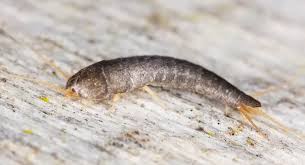How to Get Rid of Silverfish Without Chemicals
What are Silverfish?
Lepisma saccharina, or the common silverfish, is a wingless insect that wriggles around when it moves. Silverfish bugs get their name because of its silvery color and strong resemblance to a fish. They rely mostly on carbohydrates to survive that come from starches and natural sugars.
Silverfish and their cousins the firebrats are nocturnal bugs that are usually between a half and one inch in length. They also have two long antennae at the back of their abdomens and have a set of eyes at the front of their bodies.
Firebrats and silverfish are considered to be some of the most damaging insects because of their ability to multiply quickly and destroy property. They will continuously feast on whatever food sources they find in the house and are quick to move around the rest of the house in search of more food.
Over the course of their lifetime, an adult silverfish can have as many as 66 offspring. If you have silverfish in your house, they are likely seeking food, a better environment, or more space to grow their population.
Silverfish find their way into homes through cracks and gaps around doors, windows, and walls, as wells as through foundation cracks. They can even find their way inside on boxes or bags from other infested locations. Once they see a hospitable place, they will likely remain there until you get rid of them.

Where do Silverfish Live?
Silverfish prefer dark, damp, moist areas — as do a variety of other household pests. Fortunately, this means that your efforts to get rid of them will also kill off many other bugs in your home, too.
They love the taste of paper and wet wood. You’ll typically find them around books, magazines, cereal boxes, storage boxes, and behind wallpaper, along with damp or rotting window sills or cupboards.
The best places to look for them are:
- Bathrooms
- Under sinks
- Laundry room
- Basement
- Closets
- Attics
Home Remedies for Silverfish and Fish Moth
Spread Boric Acid Along the Floor
Boric acid is an excellent weapon against household bugs like silverfish bugs. When ingested, boric acid can cause havoc in the bug’s stomach. The powder can also scratch and dry out the fish moth’s exoskeleton due to its abrasive nature. Spread the boric acid along all corners of the floor and in dark spaces such as the wardrobe and bedroom cabinets. Boric acid doesn’t kill pests immediately so you may not notice any effects until a week has passed.
Boric acid should be used carefully despite being a substance that occurs naturally. All safety precautions (e.g. masks, gloves) should be taken to limit the powder’s exposure to your body. Pet owners and families with young children should use food-grade diatomaceous earth as a safer alternative to boric acid.
Sprinkle Food-Grade Diatomaceous Earth
Food-grade diatomaceous earth has a similar effect to boric acid. To insects, diatomaceous earth can feel like shattered glass due to its microscopic sharp edges. Please make sure you get the food-grade version and not the pool-grade version. Sprinkle a liberal amount of food-grade diatomaceous earth on common silverfish hiding spots, such as bookcases and wardrobes. Be persistent and patient. Re-apply the powder once every few weeks and you should eventually see the silverfish bugs disappear.
Reduce Moisture with a Dehumidifier
Silverfish bugs like to relocate to dark, damp places. You should see an immediate difference after the humidity level is reduced in your home. It’s worthwhile investing in a dehumidifier if you live in an area that has high humidity levels. In some cases, the high humidity may be due to some sort of house maintenance issue, such as a leaking pipe or a leaking roof. Repairing these issues should make a huge difference in the presence of fish moths and other bugs that thrive in high-humidity environments.
Place Cedar Blocks to Repel Silverfish Bugs
Some studies have concluded that cedar can repel pests like silverfish bugs due to the strong aroma that’s given off by the cedar essential oil.
If you don’t mind the scent of cedar then consider placing some cedar blocks in various places around your home, such as the cabinets and windowsills. Cedar hangers may also help keep the silverfish bugs away from your valuable clothes.
Discard Old Newspapers and Cardboard Boxes
Silverfish bugs and fish moths love to feed on starchy paper-based material. Some homeowners have had their valuable books ruined due to a lack of control against the silverfish population. One of the first steps to eliminating silverfish bugs is to discard any unneeded paper materials. This includes old newspaper, cardboard boxes, old magazines, and crumbling wallpaper. You should also try to donate any books that you are no longer going to read. Hoarding will only make it more likely for silverfish bugs to appear in your home.
Seal Up Food
You don’t want to pour out a bowl of your favorite cereal just to find it’s swimming with these squirming insects. Penn State recommends sealing dry goods like cereal, pasta, rice, quinoa, flour, sugar, and pet food in sturdy, airtight containers to prevent silverfish from reaching these tempting food sources.
Keeping Silverfish Away
I followed up with these steps about six months later. Whilst I still found the odd few Silverfish, it was nothing to what I had found the first time. Also, I had no more damaged items in my wardrobe, which was a relief. Ever since, I make sure to re-do this method once a year and rarely if ever do I find any.
- Make it a habit to spray some lavender oil around the skirting boards or cupboard doors to refresh the scent and keep those nasties away in between your big cleanings.
- Try and leave areas as clutter-free as possible.
- Keep paper to a minimum. If you do need to store it, try using plastic containers that are air-tight. There are a few key things that Silverfish are attracted to, but paper is one of them.

Seal Up Food
You don’t want to pour out a bowl of your favorite cereal just to find it’s swimming with these squirming insects. Penn State recommends sealing dry goods like cereal, pasta, rice, quinoa, flour, sugar, and pet food in sturdy, airtight containers to prevent silverfish from reaching these tempting food sources.